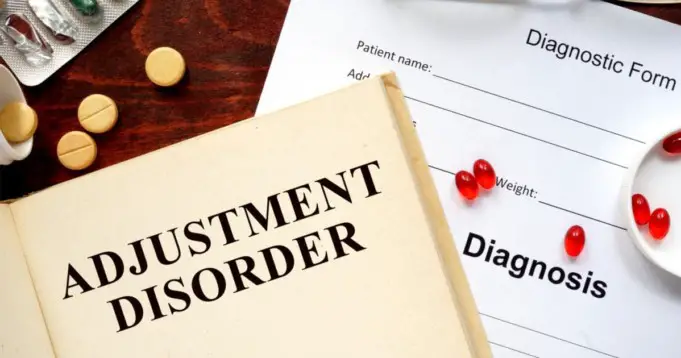Adjustment disorder can be characterized as a set of conditions that may occur when a person is having difficulty dealing with stressful life events.
These events could include relationship issues, death of a loved one, or getting laid off from work. While stress is inevitable, some individuals find it challenging to handle some stressors. Adjustment disorder can affect both children and adults.
Complications adjusting to stressful events may trigger one or more extreme psychological symptoms. It could even cause some physical symptoms. There are six distinct types of adjustment disorders and each with its signs and symptoms.
Treatment of these disorders may be possible using medications, therapy, or the combination of both. A person dealing with adjustment disorder can make a full recovery with proper attention.
Unless stressor persists, the disorder shouldn’t last more than six months.
Recognizing symptoms of adjustment disorder
The physical and mental symptoms linked with adjustment disorder typically manifest during or immediately after a person has experienced a stressful event.
Even though the disorder doesn’t last more than half a year, symptoms may persist if a person is continually exposed to stressors. While some individuals can experience one symptom, others may experience more than one.
Mental symptoms associated with adjustment disorders can include:
- Anxiousness
- Impulsive or rebellious actions
- Crying
- The feeling of hopelessness, sadness
- The feeling of being trapped or claustrophobic
- Withdrawn
- Suicidal thoughts
- Lack of concentration
- Low self-esteem
Physical symptoms may include;
- Fatigue
- Insomnia
- Indigestion
- Muscle trembling or twitching
- Soreness or body pain
The six different types of adjustment disorder include the following:
1. Adjustment disorder & depressed mood
Individuals diagnosed with this kind of adjustment disorder tend to experience feelings of hopelessness and sadness. People with adjustment disorder can also experience crying.
They may also find social activities uninteresting as they can quickly become depressed.
2. Adjustment disorder & anxiety
Complications associated with adjustment disorder and anxiety can include the feeling of being overwhelmed, worried, or anxious. Patients with this disorder may have issues with memory and concentration.
Children with this disorder are commonly diagnosed with having separation anxiety from loved ones and their parents.
3. Adjustment disorder & depressed mood and mixed anxiety
Individuals with this kind of adjustment condition may experience both anxiety and extreme mood swings.
4. Adjustment disorder & disturbance of conduct
People diagnosed with the symptoms of this type of adjustment disorder generally involve behavioral issues like starting a fight or driving recklessly.
Teenagers with the disorder may often become destructive or resort to stealing. They don’t mind skipping classes.
5. Adjustment disorder & mixed disturbance of emotions and conduct
The symptoms associated with this type of adjustment disorder include anxiety, depression, and behavioral problems.
6. Adjustment disorder unspecified
People diagnosed with adjustment disorder “unspecified” have symptoms that are not associated with the other types of adjustment disorder. Adjustment disorder unspecified may often include physical symptoms or issues with friends, family, school, or work.
Causes
Several stressful events can lead to an adjustment disorder. Some common causes of adjustment disorder in adults may include:
- Relationship problems like divorce
- Death of a loved one
- Losing a job
- Natural disasters
- Major life change
- Illness in a family, friend or you
- Financial issues
- Geographical change
Some common causes of adjustment disorder in children and teens may include:
- Bullying
- Family issues
- Sickness
- Anxiety over their sexuality
- Issues in school
Risk of adjustment disorder
Adjustment disorder can affect anyone. There is no direct way of telling who out of a group of people encountering the same stressor will have one.
Your coping mechanism and social skills with other stressors can determine if a person would develop adjustment disorder.
Diagnosing adjustment disorder
Before a person can be diagnosed with adjustment disorder, specific criteria must be met, and some of them include;
- Experiencing behavioral or psychological symptoms that lasts up to three months caused by an identifiable stressor or stressors
- Been exposes to stress than you can handle
- Symptoms that are not a result of other diagnoses
- Improvements of symptoms within five to six months after stressor or stressors are excluded
Treatment
A person diagnosed with an adjustment disorder may only require short-term treatment or treatment that could last for an extended period of time. The treatment of adjustment disorder may require medications, therapy, or a combination of both.
Therapy
Therapy is the leading treatment for adjustment disorder. Your healthcare provider or doctor may suggest you see a mental health therapist.
You may be referred to a mental health counselor or a psychologist. Nevertheless, you may be referred to a psychiatrist if your doctor thinks the condition demands medication.
The option of therapy gives room for regular social activities. Your therapist would offer an emotional guide as well as address the cause of your adjustment disorder.
Understanding the cause of the adjustment disorder may help you coping mechanisms that can be used to handle future stressors.
Different types of therapies can be used to treat adjustment disorder, and they include the following;
- Family and group support therapy
- Support groups targeted at the cause of the disorder
- Psychotherapy (also referred to as talk therapy or counseling)
- Interpersonal psychotherapy or psychotherapy treatment
- CBT or Cognitive behavior therapy which centers on solving issues by changing unproductive behaviors and thinking
Medication
Some individuals with adjustment disorders also benefit from taking drugs. The use of medications can be used to minimize some of the symptoms of adjustment disorders, such as depression, insomnia, and anxiety.
These medications include:
benzodiazepines, such as lorazepam (Ativan) and alprazolam (Xanax) nonbenzodiazepine anxiolytics, such as gabapentin (Neurontin) SSRIs or SNRIs, such as sertraline (Zoloft) or venlafaxine (Effexor XR).
Outlook
Recovery is possible if adjustment disorder is treated immediately and correctly. Adjustment disorder doesn’t last longer than six months if addressed quickly.
Preventing adjustment disorder
There’s no definite way to keep adjustment disorder from happening. Nonetheless, it helps when a person with the disorder is resilient, gets help, and improve on their coping mechanism.
Some of the ways to maximize your resilience include;
- Healthy living
- Improving self-esteem
- Seeing the good in every hard situation
- Avoiding things, places or people that can stress you
- Being around people who support you and improve your mental health
It can be beneficial to make provision for a stressful situation if you know you won’t be able to avoid it in the nearest future. Positive thinking can be very helpful.
Consulting with your doctor or therapist for advice on how best to manage stressful situations is also an excellent way to deal with adjustment disorder.
Have you ever had to deal with an adjustment disorder? What are your triggers? What methods did you use in handling the condition? Do share with us in the comments below.












